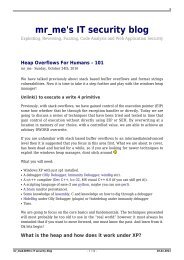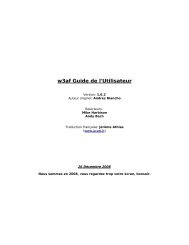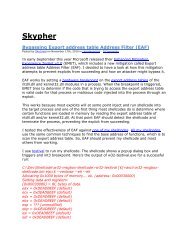Create successful ePaper yourself
Turn your PDF publications into a flip-book with our unique Google optimized e-Paper software.
<strong>C<strong>over</strong>t</strong> <strong>Channel</strong> <strong>over</strong> <strong>ICMP</strong><br />
By: Debasish Mandal<br />
http://www.debasish.in/<br />
Date: 15/08/2011
Contents:<br />
Introduction<br />
Some key points about <strong>ICMP</strong><br />
Some key points about firewalls<br />
Uses of <strong>ICMP</strong> c<strong>over</strong>t channel<br />
Breaking an <strong>ICMP</strong> ping<br />
Handmade raw ping using python<br />
Establish a simple <strong>ICMP</strong> c<strong>over</strong>t channel<br />
between two host using python<br />
Server and Client source Code.<br />
Few other well known c<strong>over</strong>t channel tools<br />
Mitigation
Introduction and Overview:<br />
An <strong>ICMP</strong> c<strong>over</strong>t tunnel establishes a c<strong>over</strong>t connection between two computers using <strong>ICMP</strong><br />
echo requests and reply packets. An example of this technique is tunneling complete TCP traffic<br />
<strong>over</strong> ping requests and replies. More technically we can say <strong>ICMP</strong> c<strong>over</strong>t tunneling works by<br />
injecting arbitrary data into an echo packet sent to a remote computer. The remote computer<br />
replies in the same manner, injecting an answer into another <strong>ICMP</strong> packet and sending it back.<br />
Some Key Points about <strong>ICMP</strong>:<br />
<strong>ICMP</strong> Doesn't Have Ports:<br />
We can't actually ping a port. When someone speaks of "pinging a port" they are actually<br />
referring to using a layer 4 protocol (such as TCP or UDP) to see if a port is open or not. So if<br />
someone "pings" port 80 on a box, that usually means send it a TCP SYN to that system in order<br />
to see if it's responding. Real ping uses <strong>ICMP</strong>, which doesn't use ports at all.<br />
<strong>ICMP</strong> Works At Layer Three (3)<br />
While <strong>ICMP</strong> sits "on top of" IP, <strong>ICMP</strong> is not a layer 4 protocol. It's still considered to be at<br />
layer 3 rather than one layer higher.<br />
Network layer routes the packets according to the unique network addresses. Router works as<br />
the post office and network layer stamps the letters (data) for the specific destinations.<br />
Protocols: These protocols work on the network layer IP, <strong>ICMP</strong>, ARP, RIP, OSI, IPX and OSPF.<br />
Network Devices: Network devices including Router, Brouter, Frame Relay device and ATM<br />
switch devices work on the network layer.
Some Key Points about Firewalls:<br />
Firewalls operate at different layers to use different criteria to restrict traffic. The lowest layer<br />
at which a firewall can work is layer three. In the OSI model this is the network layer. In TCP/IP<br />
it is the Internet Protocol layer. This layer is concerned with routing packets to their<br />
destination. At this layer a firewall can determine whether a packet is from a trusted source,<br />
but cannot be concerned with what it contains or what other packets it is associated with.<br />
Firewalls that operate at the transport layer know a little more about a packet, and are able to<br />
grant or deny access depending on more sophisticated criteria. At the application level,<br />
firewalls know a great deal about what is going on and can be very selective in granting access.<br />
It would appear then, that firewalls functioning at a higher level in the stack must be superior in<br />
every respect. This is not necessarily the case. The lower in the stack the packet is intercepted,<br />
the more secure the firewall. If the intruder cannot get past level three, it is impossible to gain<br />
control of the operating system.<br />
Uses of <strong>ICMP</strong> <strong>C<strong>over</strong>t</strong> <strong>Channel</strong>:
<strong>ICMP</strong> tunneling can be used to bypass firewalls rules through obfuscation of the actual traffic.<br />
Depending on the implementation of the <strong>ICMP</strong> tunneling software, but this type of connection<br />
can also be categorized as an encrypted communication channel between two computers.<br />
Without proper deep packet inspection or log review, network administrators will not be able<br />
to detect this type of traffic through their network.<br />
Breaking an <strong>ICMP</strong> packet:<br />
To break an <strong>ICMP</strong> packet we are going to send <strong>ICMP</strong> echo requests to a remote host and sniff<br />
the network traffic.<br />
Let’s have a look at a normal ping.<br />
Here we are sending normal <strong>ICMP</strong> echo request to the remote host 192.168.157.1.
Capturing the traffic using Wire shark we can see this:<br />
As we have used the basic ping utility with no options, it’s sent multiple <strong>ICMP</strong> echo requests to<br />
the host. So it will be bit complicated for us to analyze the entire traffic. So let’s send a single<br />
<strong>ICMP</strong> packet with 0 bytes of data.<br />
Here we can use following command to send an <strong>ICMP</strong> packet with 0 bytes of payload.<br />
ping –c 1 –s 0
Now it will be easier for us to analyze the traffic.<br />
In sniffer in the remote host we can see we have received 42 bytes of data.<br />
If we look at a typical <strong>ICMP</strong> packet structure it will like below figure.<br />
A typical <strong>ICMP</strong> Header structure is like:<br />
Figure 1<br />
Analyzing those 42 bytes of data we can understand 1 st 14 bytes is the Ethernet Header.<br />
In the Ethernet header the 1 st 12 bytes you can see that this is nothing but the Hardware<br />
addresses of the Destination and source machine.<br />
The next 20 BYTE of the received datagram is the IP Header. (This supports the Figure 1)<br />
The IP header structure in more details:
Now the next 8 bytes is <strong>ICMP</strong> Header:<br />
<strong>ICMP</strong> Header Structure in more details:<br />
This also supports figure 2.<br />
The ping utility present in a typical Linux system actually allows us to control number of<br />
packets, size of packets, but if we want to craft a ping in more detail it will not allow us to do<br />
that. As our main objective is to manipulate the data portion <strong>ICMP</strong> packet so using normal<br />
utility ping is not a good choice.<br />
HPING2:<br />
Hping is a free packet generator and analyzer for the TCP/IP protocol distributed by Salvatore<br />
Sanfilippo (also known as Antirez) using this we can also control / and manipulate the data part<br />
of a single <strong>ICMP</strong> packet. Here again we are going to send a single <strong>ICMP</strong> echo packet with the<br />
help of hping but this time we are going to add some junk data with the <strong>ICMP</strong> packet.
You can see in the screenshot that we have added 4 “A” s with the <strong>ICMP</strong> packet and sent it to<br />
the HOST 192.168.157.1.<br />
Let’s sniff the traffic and analyze it.<br />
Now you can see we have captured 46(42+4) bytes of data and in the screen shot you can easily<br />
see our payload that’s highlighted.41 is the HEX representation of “A”.<br />
Handmade raw PING: Life is short, I always prefer python:<br />
In the above examples we have used normal ping utility and hping to send <strong>ICMP</strong> echo request<br />
to any host. Now we are going to use a python to send a handmade raw <strong>ICMP</strong> echo packet.<br />
In this case we are not only crafting <strong>ICMP</strong> header and the payload of the packet but also the<br />
Ethernet Header, IP header part.
The variable “dump” in the above mentioned script is holding entire datagram.Includng<br />
Ethernet header IP header and <strong>ICMP</strong> header and also the payload. Here I have put 41 that<br />
mean 4 no. of “A”s.<br />
Now from the above discussion it’s clear that we can easily send arbitrary data to any host by<br />
injecting the data into an echo packet. Now if we can plant a demon in the remote host which<br />
can replies in the same manner, injecting an answer into another <strong>ICMP</strong> packet and sending it<br />
back.<br />
Packing all these together:<br />
If we can implement following feature into one program then we can do exactly the same thing<br />
1) A daemon will be running which will sniff all <strong>ICMP</strong> packets.<br />
2) After receiving a ping, extract the payload (valid query from attackers’ side) from ping<br />
packets.<br />
3) Do necessary things depending on the query received through ping.<br />
4) Ping back with the answers of the query.<br />
Here I have written a simple <strong>ICMP</strong> tunneling server and a client in python to establish a c<strong>over</strong>t<br />
channel between two hosts.<br />
Code for Server:<br />
http://pastebin.com/JLD6grb2<br />
Code for Client:
http://pastebin.com/gH3zzHdQ<br />
This c<strong>over</strong>t channel daemon basically receives OS commands from ping and executes the<br />
command on the remote host and ping us back the command output. Once the daemon is<br />
started on host it will start sniffing <strong>ICMP</strong> packets. After receiving commands from the client it<br />
will extract the payload from the ping packets and execute the command on that host and ping<br />
us back the output. If the command output is long the daemon will send the output through<br />
multiple pings.<br />
The client side sniffer will receive the response packets and extract the command output from<br />
payload. After parsing the command out put it will show the output. The tool Hping can also be<br />
used as a client of this daemon. In that case the payload should be crafted in a particular<br />
pattern so that the daemon can recognize the query. In that case the client script should be<br />
used as a response parser or in wire-shark.<br />
A video demo of this <strong>C<strong>over</strong>t</strong> <strong>Channel</strong> can be found here:<br />
http://www.youtube.com/watchv=ADHtjwwkErI<br />
Few other well known c<strong>over</strong>t channel tools:<br />
LOKI<br />
LOKI is an Information tunneling program. It uses Internet Control message Protocol echo<br />
response packet to carry its payload.<br />
N<strong>C<strong>over</strong>t</strong><br />
It hides file transfer by cloaking it in seemingly harmless data using packet forgery.<br />
Sometime its possible to hide actual IP of users.<br />
007 Shell:<br />
007 Shell is a simple client/server C program used for remotely administering a system<br />
<strong>over</strong> a network using techniques similar to Loki. Those c<strong>over</strong>t <strong>ICMP</strong> ECHO_REPLY<br />
packets encapsulate the command and response message within the packet payload.<br />
<strong>ICMP</strong>TX (IP-<strong>over</strong>-<strong>ICMP</strong>):<br />
<strong>ICMP</strong>TX is a program that allows a user with root privledges to create a virtual network link<br />
between two computers, encapsulating data inside of <strong>ICMP</strong> packets.
Mitigation:<br />
Preventing c<strong>over</strong>t channels reminds the cat-and-dog chase .You can prevent certain channels<br />
only if you're aware of them, can analyze the traffic they generate and then configure your IDS<br />
accordingly, e.g. write Snort rules. Still, when c<strong>over</strong>t channels generate different traffic with<br />
each packet (e.g. bit-flipping) or use advanced timing techniques, it becomes impossible to<br />
prevent them<br />
Although the only way to prevent this type of tunneling is to block <strong>ICMP</strong> traffic altogether, this<br />
is not realistic for a production or real-world environment. One method for mitigation of this<br />
type of attack is to only allow fixed sized <strong>ICMP</strong> packets through firewalls to virtually eliminate<br />
this type of behavior. Limit the size of <strong>ICMP</strong> packets. Large <strong>ICMP</strong> packet can be seen as<br />
suspicious by an IDS system that could inspect the <strong>ICMP</strong> packet and raise an alarm. However,<br />
since there are legitimate uses for large <strong>ICMP</strong> packets it is difficult to determine if a large <strong>ICMP</strong><br />
packet is malicious. For example, large echo request packets are used to check if a network is<br />
able to carry large packets. Differentiating legal from illegal large packets is even more difficult<br />
if c<strong>over</strong>t communication is encrypted. An IDS needs to be able to determine if a packet is<br />
encrypted or not. Distinguishing encrypted from non-encrypted packet still remains an open<br />
interesting research problem.<br />
Snort provides one or two rules that can help in detecting <strong>ICMP</strong> payload c<strong>over</strong>t channels. This is<br />
one example. Another example is to detect the "Dont Fragment" bit c<strong>over</strong>t channel and so on.<br />
These are simple examples. However, snort doesn't provide such rules and one needs to write<br />
them customized. In addition, there are some smart c<strong>over</strong>t channels that are very difficult to<br />
detect like the ISN c<strong>over</strong>t channel and timing c<strong>over</strong>t channels.<br />
Reference:<br />
http://danielmiessler.com/study/icmp/<br />
http://en.wikipedia.org/wiki/<strong>C<strong>over</strong>t</strong>_channel
http://en.wikipedia.org/wiki/Firewall_(computing)<br />
http://www.2factor.us/icmp.pdf
















